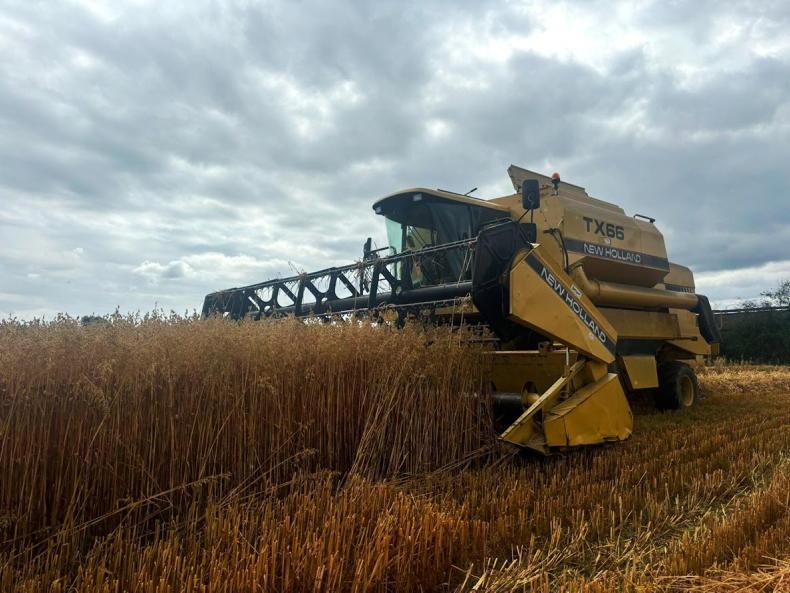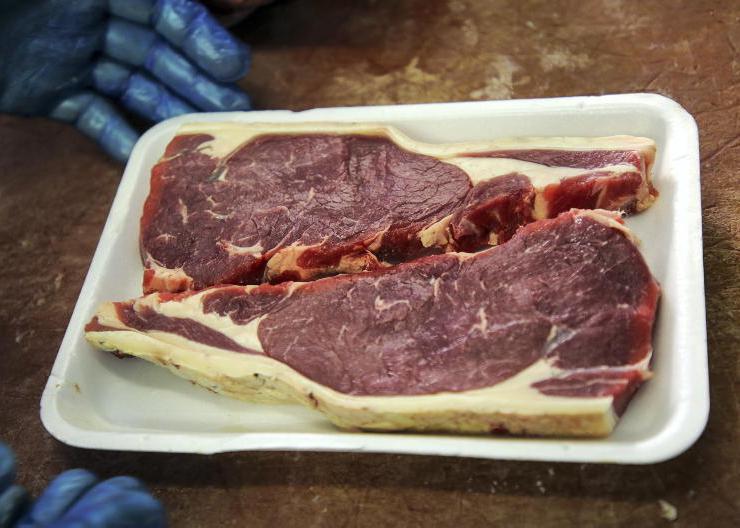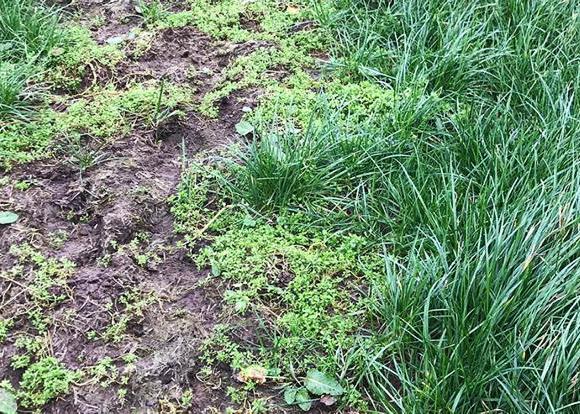It has been quiet on Barty’s farm recently as he waits for his spring barley to ripen. Since the last time we spoke to him, the winter barley straw has been baled.
There was a light straw crop, with just over three 8x4x3 square bales per acre. Once the fields were cleared, he subsoiled the tramlines to break up the compacted soil as they had become quite deep and hard in the wet spring earlier this year.
Barty also planted his ACRES environmental management of arable fallow parcel with a cover crop of phacelia and oilseed radish.
He says that this is a great mix to alleviate compaction and condition the soil.
However, he says it was in scarce supply, so he would urge farmers who want it to place their orders.
Barty thought his spring malting barley was ripe last Friday, but rather than starting to harvest it, he stuck by the old advice of “if you think it’s ripe, walk away for a couple of days”.
Therefore, he will be harvesting it in the next dry spell and hopes that the wind and rain on Monday didn’t cause too much damage to the crop.
He says some people started cutting spring barley in his area at the weekend and the yield reports are promising, around 3t/ac.
Protein is at acceptable levels, but the hectolitre weight is a bit low and is a concern for meeting the malting specification of 63KPH.
Barty hopes that the maltsters take note as the quality will probably not improve as the harvest goes on.
Straw yields are reported to be light, especially where Terpal was used, giving short crops.

Barty planting a cover crop for the ACRES environmental management of arable fallow option.
Given that there will be a lot of spring barley ripe when the weather picks up, Barty is making sure that his sheds are clean in case he needs to store grain for a few days to keep the combine going as he expects the grain intakes will be extremely busy.
Pádraig has been using the wet weather this week as an opportunity to think about his cropping plan for the coming year and what varieties to plant.
He harvested his winter wheat last week. The KWS Dawsum came in at 3.65t/ac, 20% moisture and a KPH of 73.5. The crop had some gaps in it, with at least 1ac out of 30 bare.
Pádraig is not going to grow winter wheat in the coming year as he feels that the varieties and chemistry are slipping in his high septoria pressure area. He says it’s the first year that the effects of not having Bravo can be seen.
He will replace the wheat with winter barley, as Pádraig says he can get the same yield and more bales from barley as with wheat.
The wheaten straw was sold on the flat and once the field was cleared, Pádraig spread dung on some of it before planting it with the eight-way cover crop mix.
He is interested to see if the cover crop will be richer where the dung was spread.
There are still a lot of green grains in the spring barley, but it will probably be cut in the next dry window. It remains standing and the good potential of the crop is still there.
Pádraig also has 150ac of spring barley to cut on hire so it will be a very busy time for him once the weather does come right. Once this is completed, the spring oats should be near ready to harvest.
There is still a lot of green in the crop at the moment so they will not be ripe for a week or two.
The spring beans are only starting to turn brown on top. Pádraig thinks that they may be harvested on the same day that the fields are being planted again with winter barley.
Conditions have been very wet in Galway recently, but it has not affected Conall too badly on the tillage side of the farm. He has been very busy harvesting silage, but he says that this should calm down now.
The winter barley was baled at nine round bales/ac. Once the fields were cleared, Conall planted some Redstart hybrid rape/kale at 4.5kg/ha at the start of August to be grazed by sheep over the winter months.
The winter oats were finished last week. Conall was very happy as it yielded 3.6t/ac at 17 to 18% moisture content.
There was still green straw in the crop despite the fact the grain was very ripe when cut. Therefore, it took a few dry days before the straw was fit to bale.
It came to 11 round bales/ac.
Despite the high straw demand in his area, Conall is finding it a bit more difficult to move the oaten straw compared to barley straw. However, all the straw was still sold relatively quickly.
Conall hasn’t cut any spring crops yet. Although he planted some spring barley on 1 April, it is still a few days away. Conall isn’t sure whether this is a good sign or just a result of the low levels of sunshine this year.

Conall finished harvesting his winter oats last week in Galway.
There is some secondary regrowth in the spring barley, and Conall is not sure why this is. Fortunately, the barley and oats are still standing.
The oats are about three weeks away and are slow to ripen in. The spring beans may not be harvested until October.
Losing leaves
The crop is only just starting to lose leaves, and it may lead to a very busy period where there is harvesting and planting of winter crops happening at the same time.
Conall feels that there is not as many pods on the beans as last year. He had reduced his seeding rate this year to try to prevent the beans from growing too tall, but they still reached 6ft in height.
It has been quiet on Barty’s farm recently as he waits for his spring barley to ripen. Since the last time we spoke to him, the winter barley straw has been baled.
There was a light straw crop, with just over three 8x4x3 square bales per acre. Once the fields were cleared, he subsoiled the tramlines to break up the compacted soil as they had become quite deep and hard in the wet spring earlier this year.
Barty also planted his ACRES environmental management of arable fallow parcel with a cover crop of phacelia and oilseed radish.
He says that this is a great mix to alleviate compaction and condition the soil.
However, he says it was in scarce supply, so he would urge farmers who want it to place their orders.
Barty thought his spring malting barley was ripe last Friday, but rather than starting to harvest it, he stuck by the old advice of “if you think it’s ripe, walk away for a couple of days”.
Therefore, he will be harvesting it in the next dry spell and hopes that the wind and rain on Monday didn’t cause too much damage to the crop.
He says some people started cutting spring barley in his area at the weekend and the yield reports are promising, around 3t/ac.
Protein is at acceptable levels, but the hectolitre weight is a bit low and is a concern for meeting the malting specification of 63KPH.
Barty hopes that the maltsters take note as the quality will probably not improve as the harvest goes on.
Straw yields are reported to be light, especially where Terpal was used, giving short crops.

Barty planting a cover crop for the ACRES environmental management of arable fallow option.
Given that there will be a lot of spring barley ripe when the weather picks up, Barty is making sure that his sheds are clean in case he needs to store grain for a few days to keep the combine going as he expects the grain intakes will be extremely busy.
Pádraig has been using the wet weather this week as an opportunity to think about his cropping plan for the coming year and what varieties to plant.
He harvested his winter wheat last week. The KWS Dawsum came in at 3.65t/ac, 20% moisture and a KPH of 73.5. The crop had some gaps in it, with at least 1ac out of 30 bare.
Pádraig is not going to grow winter wheat in the coming year as he feels that the varieties and chemistry are slipping in his high septoria pressure area. He says it’s the first year that the effects of not having Bravo can be seen.
He will replace the wheat with winter barley, as Pádraig says he can get the same yield and more bales from barley as with wheat.
The wheaten straw was sold on the flat and once the field was cleared, Pádraig spread dung on some of it before planting it with the eight-way cover crop mix.
He is interested to see if the cover crop will be richer where the dung was spread.
There are still a lot of green grains in the spring barley, but it will probably be cut in the next dry window. It remains standing and the good potential of the crop is still there.
Pádraig also has 150ac of spring barley to cut on hire so it will be a very busy time for him once the weather does come right. Once this is completed, the spring oats should be near ready to harvest.
There is still a lot of green in the crop at the moment so they will not be ripe for a week or two.
The spring beans are only starting to turn brown on top. Pádraig thinks that they may be harvested on the same day that the fields are being planted again with winter barley.
Conditions have been very wet in Galway recently, but it has not affected Conall too badly on the tillage side of the farm. He has been very busy harvesting silage, but he says that this should calm down now.
The winter barley was baled at nine round bales/ac. Once the fields were cleared, Conall planted some Redstart hybrid rape/kale at 4.5kg/ha at the start of August to be grazed by sheep over the winter months.
The winter oats were finished last week. Conall was very happy as it yielded 3.6t/ac at 17 to 18% moisture content.
There was still green straw in the crop despite the fact the grain was very ripe when cut. Therefore, it took a few dry days before the straw was fit to bale.
It came to 11 round bales/ac.
Despite the high straw demand in his area, Conall is finding it a bit more difficult to move the oaten straw compared to barley straw. However, all the straw was still sold relatively quickly.
Conall hasn’t cut any spring crops yet. Although he planted some spring barley on 1 April, it is still a few days away. Conall isn’t sure whether this is a good sign or just a result of the low levels of sunshine this year.

Conall finished harvesting his winter oats last week in Galway.
There is some secondary regrowth in the spring barley, and Conall is not sure why this is. Fortunately, the barley and oats are still standing.
The oats are about three weeks away and are slow to ripen in. The spring beans may not be harvested until October.
Losing leaves
The crop is only just starting to lose leaves, and it may lead to a very busy period where there is harvesting and planting of winter crops happening at the same time.
Conall feels that there is not as many pods on the beans as last year. He had reduced his seeding rate this year to try to prevent the beans from growing too tall, but they still reached 6ft in height.











SHARING OPTIONS